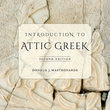 Accentuation Tutorial
Accentuation Tutorial

|
TOPICS Accent and Accent-Marking in Ancient Greek The Last 3 Syllables and the Accents Persistent Accentuation |
Gradually the Koine of the Hellenistic and Roman periods underwent a change in accentuation along with many other linguistic changes. By 400 C.E. a stress accent had fully supplanted the pitch accent. Subsequently, accent marking became even more necessary for dealing with the great literature of the past. In the ninth century C.E. Byzantine scholars modified and extended the accent-marking system, producing the conventions we now follow. 
Extract of an image of a 16th-century Greek manuscript |
||||